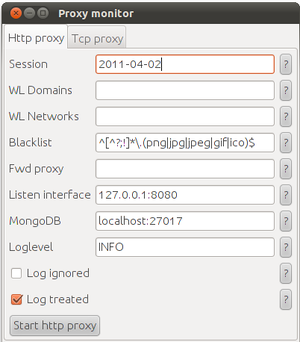This site is the archived OWASP Foundation Wiki and is no longer accepting Account Requests.
To view the new OWASP Foundation website, please visit https://owasp.org
OWASP Hatkit Proxy Project
Main
The Hatkit Proxy is an intercepting http/tcp proxy which is based on the Owasp Proxy.
Background
The primary purpose of the Hatkit Proxy is to create a minimal, lightweight proxy which stores traffic into an offline storage where further analysis can be performed, i.e. all kinds of analysis which is currently implemented by the proxies themselves (webscarab/burp/paros etc).
Also, since the http traffic is stored in a MongoDB, the traffic is stored at an object-level, retaining the structure of the parsed traffic.
Hatkit proxy features
The additions which have been implemented on top of Owasp Proxy are:
- Swing-based UI,
- Interception capabilities with manual edit, both for TCP and HTTP traffic,
- Syntax highlightning (html/form-data/http) based on JFlex,
- Storage of http traffic into MongoDB database,
- Possibilities to intercept in Fully Qualified mode (like all other http-proxies) OR Non-fully qualified mode. The latter means that interception is performed *after* the host has been parsed, thereby enabling the user to submit non-valid http content.
- A set of filters to either ignore or process traffic which is routed to the proxy. The 'ignored' traffic will be streamed to the endpoint with minimal impact on performance.
Getting started
To use the proxy, download the zip-file which can be found on the source code repository (you can also use the direct-link on the release-page).
$ wget http://martin.swende.se/hgwebdir.cgi/hatkit_proxy/raw-file/tip/hatkit.zip $ unzip hatkit.zip $ java -jar hatkit/hatkit-proxy.jar
The proxy window should now pop up. It has one tab for HTTP-proxy mode, and another for TCP-proxy mode.
Before the proxy actually starts, you need to make some settings. These are all documented within the application, if you click the ?-button, you will see more information about the setting in question. Tip: Most of these settings can be modified later, so you don't have to restart the proxy to e.g. redefine the filters determining what is captured and what is ignored.
In order to actually store traffic, you also need to install mongodb. Please see MongoDB for suitable version for your platform. Note: MongoDB is usually also available through Linux packet managers, if you want to do it the simple way.
Roadmap
The database
More info coming about this. For now, some information on why this database is used and what that entails is outlined in this email: About MongoDB on w3af devel list
Project About
| PROJECT INFO What does this OWASP project offer you? |
RELEASE(S) INFO What releases are available for this project? | |||||||||||||||||||||||||||||||||||||||||||||
|---|---|---|---|---|---|---|---|---|---|---|---|---|---|---|---|---|---|---|---|---|---|---|---|---|---|---|---|---|---|---|---|---|---|---|---|---|---|---|---|---|---|---|---|---|---|---|
|
| |||||||||||||||||||||||||||||||||||||||||||||

